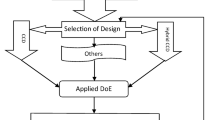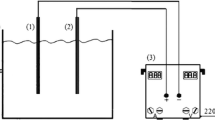Abstract
The present study illustrates the electrocoagulation remediation of paper mill wastewater for multiple response optimization. Multiple response optimization can be combined into one desirability function. All variables and responses varied for a unique global solution. The effect of basic electrocoagulation process variables pH (3–10), conductivity (3.15–10 mS/cm), electrode distance (1–2.5 cm) and current density (5–20 mA/cm2) on four response parameters such as chemical oxygen demand, color, total dissolved solids and total organic carbon has been analyzed experimentally and statistically. The global solution for these variables and responses obtained by software over a hundred design points. For unit desirability function variables conditions were pH 7.49, Conductivity 8.34 mS/cm, electrode distance 2.06 cm and current density 9.32 mA/cm2. In these global variable conditions, responses were observed to be COD 70.19%, Color 75.03%, TDS 70.69% and TOC 71.93%, respectively.








Similar content being viewed by others
References
H. Akcay, A.S. Anagun, Multi response optimization application on a manufacturing factory. Math ComputAppl 18(3), 531–538 (2013)
APHA, Standard Methods for the Examination of Water and Waste Water, 22nd edn. (American Public Health Association, Washington, DC, 2012).
Bierbaum, S., & Oeller, H.J (2009) Cost Savings in the Ozone Treatment of Paper Mill Effluents Achieved By a Closed-Loop Ozone Control System. Ozone: Sci Eng, 31(6):454–460 https://doi.org/10.1080/01919510903323141.
S. Boulaadjoul, H. Zemmouri, Z. Bendjama, N. Drouiche, A novel use of Moringaoleifera seed powder in enhancing the primary treatment of paper mill effluent. Chemosphere 206, 142–149 (2018). https://doi.org/10.1016/j.chemosphere.2018.04.123
K. Brahmi, W. Bouguerra, B. Hamrouni, E. Elalou, M. Loungou, Z. Tlili, Investigation of electrocoagulation reactor design parameters effect on the removal of cadmium from synthetic and phosphate industrial wastewater. Arab J Chem 12(8), 1848–1859 (2019). https://doi.org/10.1016/j.arabjc.2014.12.012
H.M. Bui, Optimization of electrocoagulation of instant coffee production wastewater using the response surface methodology. Pol J ChemTechnol 19(2), 67–71 (2017). https://doi.org/10.1515/pjct-2017-0030
Chaudhari PK, Majumdar B, Choudhary R, Yadav DP, & Chand S (2010) Treatment of paper and pulp mill effluent by coagulation. Environmental Technology, ID:2602658. https://doi.org/10.1080/09593330903486665.
CPCB (2019). Comprehensive industry document for large pulp and paper industry. COINDS/417/2018–2019.
G. Derringer, R. Suich, Simultaneous optimization of several response variables. QualTechnol 12, 214–219 (1980). https://doi.org/10.1080/00224065.1980.11980968
V. Gosu, S. Arora, V. Subbaramaiah, Simultaneous degradation of nitrogenous heterocyclic compounds by catalytic wet-peroxidation process using box-behnken design. Environ Eng Res 25(4), 488–497 (2020). https://doi.org/10.4491/eer.2019.159
N. Jaafarzadeh, M. Omidinasab, F. Ghanbari, Combined electrocoagulation and UV-based sulfate radical oxidation process for treatment of pulp and paper wastewater. Process Saf Environ Prot 102, 462–472 (2016). https://doi.org/10.1016/j.psep.2016.04.019
M. Kamali, Z. Khodaparast, Review on recent development on pulp and paper mill wastewater treatment. Ecotoxicol Environ Saf 114, 326–342 (2015). https://doi.org/10.1016/j.ecoenv.2014.05.005
R. Katal, H. Pahlavanzadeh, Influence of different combination of aluminum and iron electrode on electrocoagulation efficiency: Application of the treatment of paper mill wastewater. Desalination 265(1–3), 199–205 (2011). https://doi.org/10.1016/j.desal.2010.07.052
D.H. Lee, I.J. Jeong, K.J. Kim, A desirability function method for optimizing mean and variability of multiple responses using a posterior preference articulation approach. QualReliabEng 34(3), 360–376 (2018). https://doi.org/10.1002/qre.2258
S. Meshram, C. Thakur, A. Soni, Fixed bed adsorption treatment of effluent of battery recycling unit to remove Pb(II) using steam activated granular activated carbon. J Serb ChemSoc 85(7), 953–965 (2020). https://doi.org/10.2298/JSC191103015M
N. Pandey, C. Thakur, Study on treatment of paper mill wastewater by electrocoagulation and its sludge analysis. Chem Data Collect 27, 100390 (2020). https://doi.org/10.1016/j.cdc.2020.100390
Punathil, S., Kumar, V., Thakur, C.K., & Ghosh, P. (2019). Taguchi optimization of COD removal by heterogeneous Fenton process using copper ferro spinel catalyst in a fixed bed reactor. RTD, Kinetic and Thermodynamic study. J Environ Chem Eng, 7(1), 102859. https://doi.org/10.1016/j.jece.2018.102859.
B. Sadhukhan, N.K. Mondal, S. Chattoraj, Optimisation using central composite design (CCD) and the desirability function for sorption of methylene blue from aqueous solution onto Lemna major. Karbala Int J Mod Sci 2(3), 145–155 (2016). https://doi.org/10.1016/j.kijoms.2016.03.005
P. Taylor, M.A. Aghdam, H. Kariminia, S. Safari, Removal of lignin, COD, and color from pulp and paper wastewater using electrocoagulation. Desalin Water Treatment (2015). https://doi.org/10.1080/19443994.2015.1040461
C. Thakur, V. Srivastava, I.D. Mall, A.D. Hiwarkar, Mechanistic study and multi-response optimization of the electrochemical treatment of petroleum refinery wastewater. Clean: Soil, Air, Water 46(3), 1700624 (2017). https://doi.org/10.1002/clen.201700624
C. Thakur, V.C. Srivastava, I.D. Mall, Aerobic degradation of petroleum refinery wastewater in sequential batch reactor. J Environ Sci Health Part A Toxic/Hazard Subst Environ Eng 49(12), 1436–1444 (2014). https://doi.org/10.1080/10934529.2014.928557
G. Thompson, J. Swain, M. Kay, C.F. Forster, The treatment of pulp and paper mill effluent: a review. BioresTechnol 77(3), 275–286 (2001). https://doi.org/10.1016/S0960-8524(00)00060-2
D. Tibebel, Y. Kassa, A.N. Bhaskarwar, Treatment and characterization of phosphorus from synthetic wastewater using aluminum plate electrodes in the electrocoagulation process. BMC Chem 13, 107 (2019). https://doi.org/10.1186/s13065-019-0628-1
N. Tyagi, S. Mathur, D. Kumar, Electrocoagulation process for textile wastewater treatment in continuous upflow reactor. J SciInd Res 73, 195–198 (2014)
Y. Yavuz, A.S. Koparal, U.B. Ogutveren, Treatment of petroleum refinery wastewater by electrochemical methods. Desalination 258, 201–205 (2010). https://doi.org/10.1016/j.desal.2010.03.013
Z. Zaroual, H. Chaair, A.H. Essadki, K. El Ass, M. Azzi, Optimizing the removal of trivalent chromium by electrocoagulation using experimental design. ChemEng J 148, 488–495 (2009). https://doi.org/10.1016/j.cej.2008.09.040
S. Zodi, J.N. Louvet, C. Michon, O. Potier, M.N. Pons, F. Lapicque, J.P. Leclerc, Electrocoagulation as a tertiary treatment for paper mill wastewater: removal of non-biodegradable organic pollutaion and arsenic. Sep PurifTechnol 81(1), 62–68 (2011). https://doi.org/10.1016/j.seppur.2011.07.002
Author information
Authors and Affiliations
Corresponding author
Additional information
Publisher's Note
Springer Nature remains neutral with regard to jurisdictional claims in published maps and institutional affiliations.
Rights and permissions
About this article
Cite this article
Pandey, N., Thakur, C., Ghosh, P. et al. Desirability Analysis of Multiple Responses for Electrocoagulation Remediation of Paper Mill Wastewater by Using a Central Composite Design. J. Inst. Eng. India Ser. E 102, 115–125 (2021). https://doi.org/10.1007/s40034-021-00205-5
Received:
Accepted:
Published:
Issue Date:
DOI: https://doi.org/10.1007/s40034-021-00205-5




